
Sustainable Furniture Design: Creating for Tomorrow
In a world increasingly aware of its environmental impact, sustainability is no longer just a choice — it's a responsibility. The way we design and furnish our spaces speaks volumes about how we value our planet. Sustainable furniture design blends creativity, craftsmanship, and conscience — shaping homes that feel beautiful today and responsible tomorrow.
1. Beyond Aesthetic — A Mindful Design Philosophy
Sustainable design begins with intention. It's about creating pieces that endure — functionally, emotionally, and environmentally. Rather than following fleeting trends, sustainable furniture focuses on timeless forms, natural materials, and long-term usability. Each piece is designed to be cherished, repaired, and reused — not replaced.
2. Materials That Respect the Earth
At Loam & Root, we believe that what goes into your furniture matters as much as how it looks. Our approach favors responsibly sourced wood, natural finishes, and eco-friendly adhesives. Reclaimed timber, bamboo, and other renewable materials help reduce waste and protect forests, ensuring every piece you bring home carries a lighter footprint on the planet.
3. Craftsmanship That Lasts
Fast furniture may seem convenient, but it comes at a hidden cost — quality and longevity. Sustainable furniture is built to last generations, not seasons. Skilled artisans shape every joint, curve, and surface with precision and care, creating pieces that grow more beautiful with age. This dedication to durability minimizes waste and celebrates true craftsmanship.
4. Circular Design — The Future of Furniture
The concept of circular design encourages furniture that lives multiple lives. Modular construction, reusability, and recyclability are at the heart of this movement. Instead of ending up in landfills, each product can be repaired, repurposed, or passed on — keeping valuable materials in use and reducing environmental strain.
5. Local Sourcing and Ethical Production
Sustainability also means supporting local communities and reducing transportation emissions. Partnering with local artisans and small-scale workshops not only ensures authenticity but also empowers craftsmanship rooted in tradition. Ethical labor practices and fair trade sourcing strengthen the integrity of every piece we create.
6. A Home That Reflects Conscious Living
Sustainable furniture design goes beyond material — it's a lifestyle. When your home is filled with furniture that's thoughtfully made, it tells a story of purpose, connection, and care. It reminds us that beauty and responsibility can coexist — and that the future of design lies in harmony with nature, not in opposition to it.